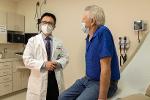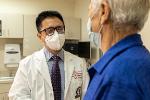Surgeon Brings FEVAR Procedure to Area Patients
TTUHSC Physician First in Region to Perform Procedure

As the body’s largest artery, the aorta delivers oxygen-rich blood from the left ventricle of the heart to important areas such as the kidneys, brain, muscles and various other organs and cells via an intricate network of smaller arteries known as arterioles and capillaries.
If an area of the aorta weakens, a balloon-like bulge known as an aortic aneurysm can form. If the weakness or bulge forms in the lower portion of the aorta, the result is an abdominal aortic aneurysm.
Wei Li, M.D., MPH, a vascular surgeon and an associate professor of surgery at the Texas Tech University Health Sciences Center (TTUHSC) School of Medicine, said smoking is the primary risk factor for developing an aortic aneurysm. Elderly Caucasian males also appear to have a higher risk of developing abdominal aneurysms.
Downloads
Video
- FEVAR PROCEDURE ANIMATION - *COURTESY: COOK MEDICAL*
- FEVAR PATIENT B-ROLL
- Wei Li, M.D.
- Leonard Routier




